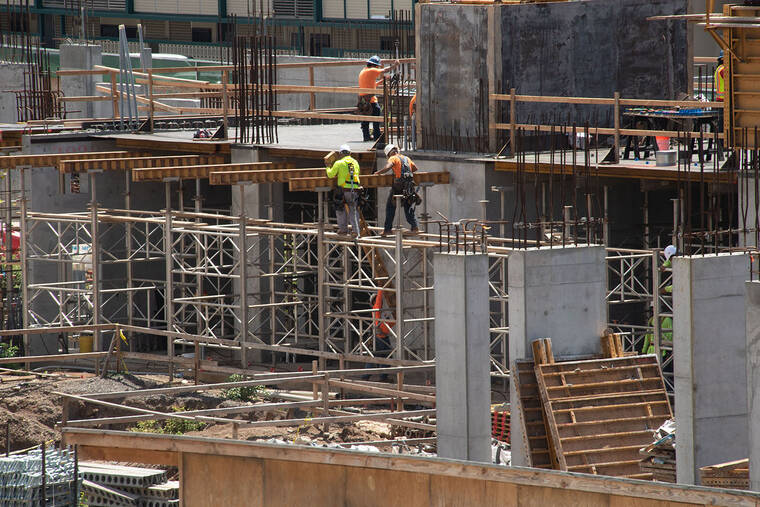Honolulu City Council OKs energy-saving building code changes
Honolulu City Council OKs energy-saving building code changes Honolulu Star-Advertiser


The Honolulu City Council Adopts Legislation to Boost Energy Efficiency and Reduce Solid Waste

The Honolulu City Council has adopted two separate but related pieces of legislation focused on boosting energy efficiency in new construction dwellings and reusing old construction materials to reduce the stream of solid waste on Oahu.
Boosting Energy Efficiency
To promote green building practices, the Council voted unanimously to pass Bill 4 — co-introduced by Chair Tommy Waters and Council member Matt Weyer earlier this year — which amends the city’s Building Energy Conservation Code to match 2020 updates in the adopted Hawaii State Energy Code.
Bill 4, as approved Wednesday, is intended to lower energy costs, reduce greenhouse gas emissions, and increase the energy resilience of new construction as a result of climate change. In addition, the bill lays the groundwork for solar and electric vehicle readiness in new construction.
For electric vehicles, the bill requires that all newly created parking stalls for newly constructed residential multi-unit and commercial buildings must feature electric vehicle chargers.
Under the bill, any newly constructed parking lots for residential multi-use buildings that add eight or more new parking stalls must have electric vehicle chargers ready for at least 25% of those stalls. Likewise, newly constructed parking for commercial buildings that adds 12 or more new stalls must have electric vehicle chargers for at least 25% of those stalls.
But there are exceptions.
- Affordable housing units offered for sale need only provide 20% of electric vehicle chargers to the total number of stalls.
- Affordable housing units offered for rent do not need to provide any electric vehicle chargers.
Meanwhile, other building code updates will require new homes to include plans for solar photovoltaic equipment, including installation of conduit and reserve panel capacity for future PV installation.
“New single-family detached dwellings, two-family detached dwellings, and duplexes shall install for each residence an electrical panel with reserved space to accommodate not less than a five Kilowatt (AC) photovoltaic system,” Bill 4 reads. “New multifamily dwellings shall install an electrical panel that includes space reserved to accommodate a photovoltaic system. … The reserved space shall be clearly labeled as solar PV ready.”
Weyer, the Council’s Housing, Sustainability and Health Committee chair, lauded the passage of Bill 4.
“We reaffirm the Council’s commitment to building a resilient and sustainable Honolulu for future generations through achieving Hawaii’s net-zero energy targets by 2050,” Weyer said in a written statement. “However, energy codes also have the potential to negatively impact the cost of housing. Immense effort has gone into this bill to strike a balance between our sustainability aspirations and housing affordability.”
Reducing Solid Waste
At the same meeting, the Council voted 8-0 — with Weyer absent from that portion of the meeting — to adopt Resolution 168, which urges the city administration to establish a Kapaa Quarry Transfer Station reusable material collection site pilot project.
According to the city’s 2019 Integrated Solid Waste Management Plan update, Oahu generates a total of approximately 1.7 million tons of solid waste each year from residential, commercial, and industrial sources.
To curb this accumulation of solid waste, Resolution 168 — introduced by Waters in July — states Honolulu-based Re-use Hawai‘i proposed a three-month, $90,000 pilot project to collect recovered construction materials and household items from the city’s Kapaa transfer station in Kailua in order to redistribute those recovered materials and items to the nonprofit’s Kakaako location.
The project comes with community benefits that include:
- Eligibility for income tax reductions for donors of materials
- The ability to shop for recovered materials at affordable rates
- Diverting and reusing household and building materials to reduce the strain on Oahu’s waste management system
- The promotion of a “circular economy” that relieves demand for newly produced, imported material
“The Council added $90,000 to the budget for this project, and I am proud to stand behind Resolution 23-168, a significant step towards reducing our environmental footprint and fostering a thriving, sustainable community,” Waters said in a written statement.
He added the pilot project showed the city’s commitment to environmental stewardship, community engagement, and economic growth.
Quinn Vittum, Re-use Hawai‘i’s executive director, also supported the project.
“Diverting material from transfer stations is a proven method of reducing waste and cultivating a circular economy for our community,” Vittum said in a written statement. “We strongly support this initiative and look forward to being a resource for the execution of the program.”
SDGs, Targets, and Indicators
1. Sustainable Development Goal: Affordable and Clean Energy (SDG 7)
- Target 7.2: Increase substantially the share of renewable energy in the global energy mix.
- Indicator 7.2.1: Renewable energy share in the total final energy consumption.
The article addresses SDG 7 by discussing the adoption of legislation aimed at boosting energy efficiency in new construction dwellings. The legislation promotes green building practices, including the installation of solar photovoltaic equipment and electric vehicle chargers in new construction. These measures contribute to increasing the share of renewable energy in the energy mix and reducing greenhouse gas emissions.
2. Sustainable Development Goal: Sustainable Cities and Communities (SDG 11)
- Target 11.6: By 2030, reduce the adverse per capita environmental impact of cities, including by paying special attention to air quality and municipal and other waste management.
- Indicator 11.6.1: Proportion of urban solid waste regularly collected and with adequate final discharge out of total urban solid waste generated, by cities.
The article connects to SDG 11 by discussing the adoption of legislation to reduce the stream of solid waste on Oahu. The legislation includes a pilot project to collect recovered construction materials and household items from a transfer station for redistribution and reuse. This initiative aims to reduce the strain on Oahu’s waste management system and promote a circular economy.
3. Sustainable Development Goal: Climate Action (SDG 13)
- Target 13.2: Integrate climate change measures into national policies, strategies, and planning.
- Indicator 13.2.1: Number of countries that have integrated mitigation, adaptation, impact reduction, and early warning into primary, secondary, and tertiary curricula.
The article indirectly relates to SDG 13 by discussing the adoption of legislation to increase the energy resilience of new construction in response to climate change. The legislation aims to lower energy costs, reduce greenhouse gas emissions, and promote the readiness for solar and electric vehicles in new buildings. These measures contribute to integrating climate change measures into local policies and planning.
Table: SDGs, Targets, and Indicators
| SDGs | Targets | Indicators |
|---|---|---|
| SDG 7: Affordable and Clean Energy | Target 7.2: Increase substantially the share of renewable energy in the global energy mix. | Indicator 7.2.1: Renewable energy share in the total final energy consumption. |
| SDG 11: Sustainable Cities and Communities | Target 11.6: By 2030, reduce the adverse per capita environmental impact of cities, including by paying special attention to air quality and municipal and other waste management. | Indicator 11.6.1: Proportion of urban solid waste regularly collected and with adequate final discharge out of total urban solid waste generated, by cities. |
| SDG 13: Climate Action | Target 13.2: Integrate climate change measures into national policies, strategies, and planning. | Indicator 13.2.1: Number of countries that have integrated mitigation, adaptation, impact reduction, and early warning into primary, secondary, and tertiary curricula. |
Behold! This splendid article springs forth from the wellspring of knowledge, shaped by a wondrous proprietary AI technology that delved into a vast ocean of data, illuminating the path towards the Sustainable Development Goals. Remember that all rights are reserved by SDG Investors LLC, empowering us to champion progress together.
Source: staradvertiser.com

Join us, as fellow seekers of change, on a transformative journey at https://sdgtalks.ai/welcome, where you can become a member and actively contribute to shaping a brighter future.







